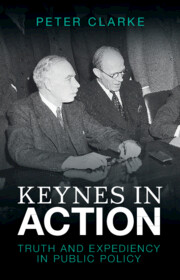Refine search
Actions for selected content:
26945 results in Economic history

Keynes in Action
- Truth and Expediency in Public Policy
-
- Published online:
- 04 November 2022
- Print publication:
- 24 November 2022
4 - The Alliance of the Disillusioned
- from Part I - Nationalism and Competitive Dynamics
-
- Book:
- Navigating Nationalism in Global Enterprise
- Published online:
- 27 October 2022
- Print publication:
- 03 November 2022, pp 95-124
-
- Chapter
- Export citation
9 - Concessions and Growth
- from Part III - Sovereignty for Sale?
-
- Book:
- Sovereignty without Power
- Published online:
- 27 October 2022
- Print publication:
- 03 November 2022, pp 217-245
-
- Chapter
- Export citation
Contents
-
- Book:
- Sovereignty without Power
- Published online:
- 27 October 2022
- Print publication:
- 03 November 2022, pp vii-viii
-
- Chapter
- Export citation
5 - From Paper to Gold
- from Part II - The Art of Survival
-
- Book:
- Sovereignty without Power
- Published online:
- 27 October 2022
- Print publication:
- 03 November 2022, pp 116-138
-
- Chapter
- Export citation
Appendix 2: - Comment on Trade Statistics for British India
- from Appendices
-
- Book:
- Navigating Nationalism in Global Enterprise
- Published online:
- 27 October 2022
- Print publication:
- 03 November 2022, pp 254-256
-
- Chapter
- Export citation
10 - Selling the Flag
- from Part III - Sovereignty for Sale?
-
- Book:
- Sovereignty without Power
- Published online:
- 27 October 2022
- Print publication:
- 03 November 2022, pp 246-270
-
- Chapter
- Export citation
Appendix 1: - Data on Liberian Economic History
-
- Book:
- Sovereignty without Power
- Published online:
- 27 October 2022
- Print publication:
- 03 November 2022, pp 283-295
-
- Chapter
- Export citation
11 - Sovereignty beyond the Age of Empires
- from Part III - Sovereignty for Sale?
-
- Book:
- Sovereignty without Power
- Published online:
- 27 October 2022
- Print publication:
- 03 November 2022, pp 271-282
-
- Chapter
- Export citation
Copyright page
-
- Book:
- Sovereignty without Power
- Published online:
- 27 October 2022
- Print publication:
- 03 November 2022, pp iv-iv
-
- Chapter
- Export citation
Bibliography
-
- Book:
- Navigating Nationalism in Global Enterprise
- Published online:
- 27 October 2022
- Print publication:
- 03 November 2022, pp 257-283
-
- Chapter
- Export citation
Acknowledgments
-
- Book:
- Navigating Nationalism in Global Enterprise
- Published online:
- 27 October 2022
- Print publication:
- 03 November 2022, pp x-xii
-
- Chapter
- Export citation
6 - The Costs of Foreign Capital
- from Part II - The Art of Survival
-
- Book:
- Sovereignty without Power
- Published online:
- 27 October 2022
- Print publication:
- 03 November 2022, pp 139-162
-
- Chapter
- Export citation
4 - Trade, Globalization, and Sovereignty
- from Part II - The Art of Survival
-
- Book:
- Sovereignty without Power
- Published online:
- 27 October 2022
- Print publication:
- 03 November 2022, pp 93-115
-
- Chapter
- Export citation
8 - Reimagining the World in Stages
- from Part II - Emergent Strategy in a World of Nations
-
- Book:
- Navigating Nationalism in Global Enterprise
- Published online:
- 27 October 2022
- Print publication:
- 03 November 2022, pp 211-245
-
- Chapter
- Export citation
Copyright page
-
- Book:
- Navigating Nationalism in Global Enterprise
- Published online:
- 27 October 2022
- Print publication:
- 03 November 2022, pp iv-iv
-
- Chapter
- Export citation
2 - Bazaar Goods “Made in Germany”
- from Part I - Nationalism and Competitive Dynamics
-
- Book:
- Navigating Nationalism in Global Enterprise
- Published online:
- 27 October 2022
- Print publication:
- 03 November 2022, pp 48-74
-
- Chapter
- Export citation
Part I - Nationalism and Competitive Dynamics
-
- Book:
- Navigating Nationalism in Global Enterprise
- Published online:
- 27 October 2022
- Print publication:
- 03 November 2022, pp 23-124
-
- Chapter
- Export citation
Tables
-
- Book:
- Sovereignty without Power
- Published online:
- 27 October 2022
- Print publication:
- 03 November 2022, pp xii-xii
-
- Chapter
- Export citation
5 - Refining Political Capabilities
- from Part II - Emergent Strategy in a World of Nations
-
- Book:
- Navigating Nationalism in Global Enterprise
- Published online:
- 27 October 2022
- Print publication:
- 03 November 2022, pp 127-156
-
- Chapter
- Export citation
